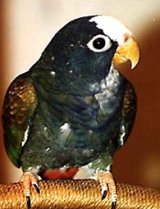
Infected birds shed large numbers of infective EBs in their oral cavity, nasal discharges, ocular secretions, crop milk, urine and feces.
Shedding of Ebs can be intermittent rather than continuous. This makes detection of chlamydia very difficult at times.
Some birds are subclinical carriers, meaning they appear normal and do not shed the organism until they are stressed. Stress can be a nutritional deficiency, a second illness, breeding, a new mate or a new location.
Young birds are most susceptible to Chlamydia and may develop a rapidly fatal illness. Adults may become infected, yet remain asymptomatic.
Different strains of Chlamydia exist which vary in their virulence. Young birds exposed to virulent strains may develop anorexia (appetite loss), conjunctivitis, dyspnea, sinusitis, tremors, biliverdinuria (green urates), emaciation, dehydration and diet within several days.
Less virulent strains can produce a subacute or protracted disese with with more subtle signs.
The next article will discuss diagnosis and treatment of Psittacosis (Parrot Fever).

